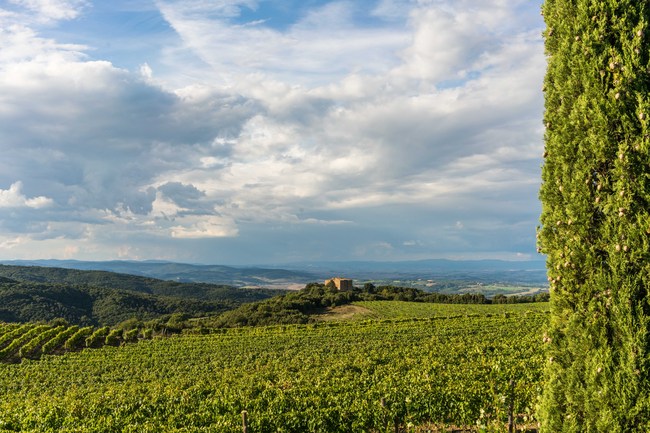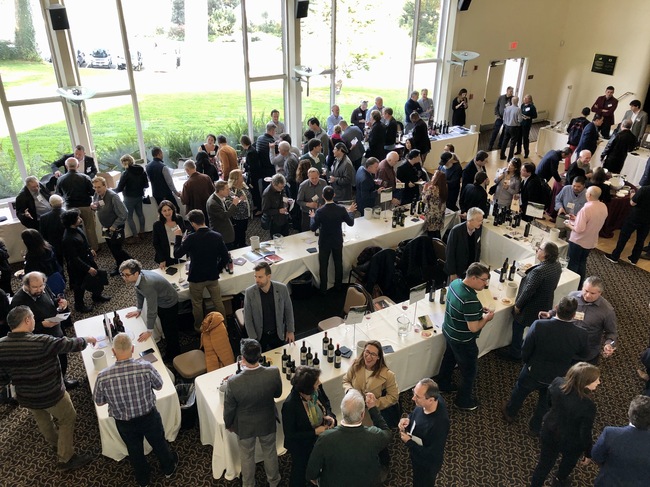
The Best Brunellos: Tasting the 2015 Vintage on Tour
Anyone who doesn’t fall even just a little bit in love with Tuscany the first time they visit should probably be locked away from the world. There’s something magical about the place that suffuses every bit of the landscape, the food, the people, and the very air.
The first time I visited with the woman I’d eventually ask to marry me, we managed to hit it perfectly at the peak of Spring — the hills were green, the poppies in full bloom, little puffy clouds in the sky, 80 degrees… you get the picture. Makes me misty-eyed just thinking about it.
While we were there, we did our share of tasting, and Ruth fell hard for Brunello. So much so that for many of her early years of wine appreciation, it became her benchmark for any red wine. “Nope, not as good as Brunello,” she would often say. Brunello (Bruno for short) still remains the planned name for our dog, if we ever get one.
For those who are perhaps less familiar with Brunello, here’s a 30-second primer. Wines can only be labeled Brunello di Montalcino if they are made from grapes grown in and around the town of Montalcino, and if they are 100% Sangiovese. There was a point a number of years ago where this could have changed, when a huge scandal rocked Italy involving several producers busted for blending Cabernet Sauvignon and Merlot into their Brunellos. The wines were banned from importation to the US for a short period of time, producers paid big fines, and the whole Consorzio had a vote to decide whether or not to change the rules of the appellation.
In the end, everyone voted to maintain the standards of the past (including, strangely, the very folks who were busted for violating those standards). Brunello will thankfully stay true to its heritage and continue to be made from 100% Sangiovese. In addition to the grape variety and locality, Brunello must be aged for no less than two years in oak, and one year in bottle, and cannot be released until 5 years after each harvest.
Because that’s a long time to keep a wine around without being able to sell it, winemakers may also produce a Rosso di Montalcino, which also must be 100% Sangiovese, but can be sold after just one year of oak aging.
Producers in the region can also make wines from more international grape varieties like Cabernet that used to be known as Super Tuscans before the region won approval for a special designation known as Sant’Antimo IGT (Indicazione Geografica Tipica).

Brunelli, like young Bordeaux, are somewhat more difficult to judge in their youth for those not used to tasting them. The wines can often be tight and tannic, and many don’t show the soft, lush fruit qualities that can emerge after a few years and a little air. But as in many regions around the world, global warming is pushing ripeness and accessibility sometimes out of the winemakers control.
Sadly, I haven’t had a chance to get back to Montalcino since that first trip Ruth and I took more than 15 years ago. But thankfully, sometimes, Tuscany can come to you. That is, if you’re a member of the wine trade living in New York or San Francisco. The Consorzio del Vino Brunello di Montalcino, the trade group representing the appellation, has resumed (after something of a hiatus) their “Benvenuto Brunello” tastings in the United States, which involve packing up a bunch of producers and touring them around with their wines.
So when they showed up in San Francisco a few weeks ago, I made sure to keep my afternoon free. This year’s version of the event was somewhat smaller than in past years, with many of the producers listed in the tasting booklet not in attendance. Extenuating circumstances being what they are, this was somewhat understandable.
Most of the wines on offer were from the 2015 vintage, a vintage that has been hyped far out of proportion to its quality I believe. The year was unusually hot and dry in general, though the microclimates of Montalcino ensure that most generalizations about a vintage in the area are fairly inaccurate for many producers. Apparently there were some truly spectacular wines made in 2015, but I don’t think any of those producers made it to San Francisco. There were certainly some standouts in the fifty or so producers whose wares I sampled, but no true superstars. While I don’t taste Brunello widely enough or consistently enough to be able to truly pass judgement on the quality of one vintage in comparison with another, I did find myself surprised that the wines weren’t better. I was encouraged, however, by a continued overall retreat from the flavor of new French oak — an ongoing (and very positive in my opinion) trend in the region.
So here are my scores and notes for the wines I tasted a few weeks ago. As with all scores and tasting notes made en masse at walk-around tastings, these are to be taken with a grain of salt, as they don’t reflect the concentrated attention, time, or controlled circumstances of a sit-down tasting.

WINES WITH A SCORE BETWEEN 9 AND 9.5
2015 Il Poggione Brunello di Montalcino, Tuscany, Italy
A medium, cloudy garnet color in the glass, this wine smells of cherry, flowers and sour cherry aromas. In the mouth, the wine is gorgeously bright and juicy with flavors of cherry, sour cherry, and dusty herbal notes all draped in gauzy tannins. Wonderful length and balance with fantastic acidity. Long, persistent finish. 16,600 cases made. Score: between 9 and 9.5. Cost: $90.
WINES WITH A SCORE AROUND 9
2015 Altesino Brunello di Montalcino, Tuscany, Italy
Light to medium ruby in the glass, this wine smells of earthy, floral berries. In the mouth the wine is polished and refined with juicy cherry and cedar flavors wrapped in a blanket of fine tannins. Clean and bright. 10,000 cases made. Score: around 9. Cost: $54.
2015 Altesino “Montosoli” Brunello di Montalcino, Tuscany, Italy
Light to medium ruby in color, this wine has a wonderful floral aspect with aromas of cherry and citrus peel. In the mouth, bright sour cherry and cherry flavors have a wonderful juiciness thanks to excellent acidity. Wonderfully long finish with fine grained tannins. 1200 cases made. Score: around 9. Cost: $129.
